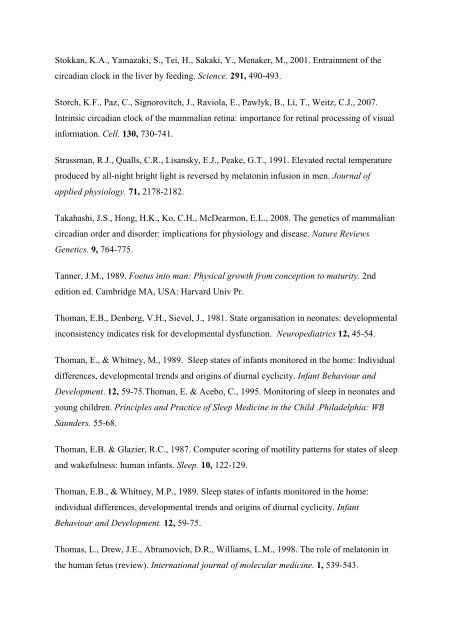The Development of Circadian Rhythms in Human Infants
The Development of Circadian Rhythms in Human Infants
The Development of Circadian Rhythms in Human Infants
You also want an ePaper? Increase the reach of your titles
YUMPU automatically turns print PDFs into web optimized ePapers that Google loves.
Stokkan, K.A., Yamazaki, S., Tei, H., Sakaki, Y., Menaker, M., 2001. Entra<strong>in</strong>ment <strong>of</strong> the<br />
circadian clock <strong>in</strong> the liver by feed<strong>in</strong>g. Science. 291, 490-493.<br />
Storch, K.F., Paz, C., Signorovitch, J., Raviola, E., Pawlyk, B., Li, T., Weitz, C.J., 2007.<br />
Intr<strong>in</strong>sic circadian clock <strong>of</strong> the mammalian ret<strong>in</strong>a: importance for ret<strong>in</strong>al process<strong>in</strong>g <strong>of</strong> visual<br />
<strong>in</strong>formation. Cell. 130, 730-741.<br />
Strassman, R.J., Qualls, C.R., Lisansky, E.J., Peake, G.T., 1991. Elevated rectal temperature<br />
produced by all-night bright light is reversed by melaton<strong>in</strong> <strong>in</strong>fusion <strong>in</strong> men. Journal <strong>of</strong><br />
applied physiology. 71, 2178-2182.<br />
Takahashi, J.S., Hong, H.K., Ko, C.H., McDearmon, E.L., 2008. <strong>The</strong> genetics <strong>of</strong> mammalian<br />
circadian order and disorder: implications for physiology and disease. Nature Reviews<br />
Genetics. 9, 764-775.<br />
Tanner, J.M., 1989. Foetus <strong>in</strong>to man: Physical growth from conception to maturity. 2nd<br />
edition ed. Cambridge MA, USA: Harvard Univ Pr.<br />
Thoman, E.B., Denberg, V.H., Sievel, J., 1981. State organisation <strong>in</strong> neonates: developmental<br />
<strong>in</strong>consistency <strong>in</strong>dicates risk for developmental dysfunction. Neuropediatrics 12, 45-54.<br />
Thoman, E., & Whitney, M., 1989. Sleep states <strong>of</strong> <strong>in</strong>fants monitored <strong>in</strong> the home: Individual<br />
differences, developmental trends and orig<strong>in</strong>s <strong>of</strong> diurnal cyclicity. Infant Behaviour and<br />
<strong>Development</strong>. 12, 59-75.Thoman, E. & Acebo, C., 1995. Monitor<strong>in</strong>g <strong>of</strong> sleep <strong>in</strong> neonates and<br />
young children. Pr<strong>in</strong>ciples and Practice <strong>of</strong> Sleep Medic<strong>in</strong>e <strong>in</strong> the Child .Philadelphia: WB<br />
Saunders. 55-68.<br />
Thoman, E.B. & Glazier, R.C., 1987. Computer scor<strong>in</strong>g <strong>of</strong> motility patterns for states <strong>of</strong> sleep<br />
and wakefulness: human <strong>in</strong>fants. Sleep. 10, 122-129.<br />
Thoman, E.B., & Whitney, M.P., 1989. Sleep states <strong>of</strong> <strong>in</strong>fants monitored <strong>in</strong> the home:<br />
<strong>in</strong>dividual differences, developmental trends and orig<strong>in</strong>s <strong>of</strong> diurnal cyclicity. Infant<br />
Behaviour and <strong>Development</strong>. 12, 59-75.<br />
Thomas, L., Drew, J.E., Abramovich, D.R., Williams, L.M., 1998. <strong>The</strong> role <strong>of</strong> melaton<strong>in</strong> <strong>in</strong><br />
the human fetus (review). International journal <strong>of</strong> molecular medic<strong>in</strong>e. 1, 539-543.














